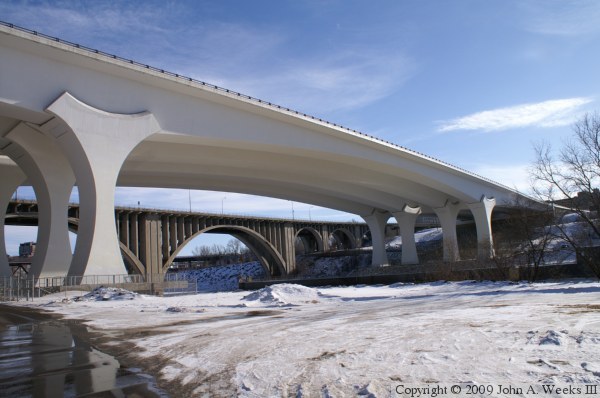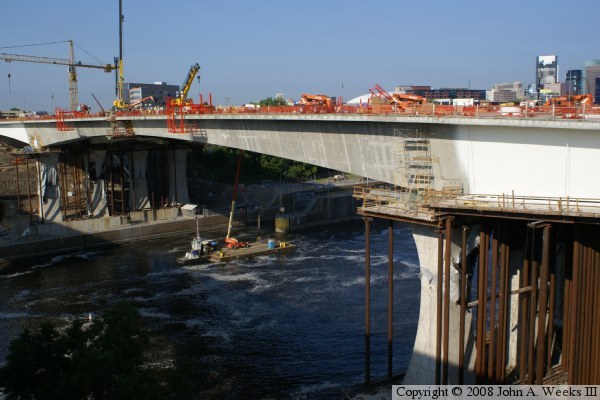This web page covers the new bridge. For information and photos on the old I-35W bridge, please click here. For complete coverage of the bridge disaster, please click here.
After the collapse, President George W. Bush visited the site, and pledged money to rebuild the bridge. Congress fully funded the project by the end of December, 2007. The new bridge is named the Saint Anthony Falls Bridge, in recognition of its proximity to lower Saint Anthony Falls, a major falls on the Mississippi River.
MN-DOT built the new bridge on a fast-track design-build plan. That is, parts of the bridge were still being designed while other parts were being built. The lead contractor was Flatiron. They won the bid despite submitting the most costly proposal.
Major construction began on October 29, 2007. The first noticeable work included pile driving for the main piers on each side of the waterway, and building a huge casting basin. The casting basin was used to cast the giant concrete segments that make up the main span of the bridge. MN-DOT promised the people of Minnesota that the new bridge would be open on December 24, 2008. Both the public and the media were skeptical that the bridge could be built that fast and still be safe.
In early May of 2008, the construction company, Flatiron, stated that they were more than half completed with the new bridge, and that it might be done as early as September or October. Flatiron had a goal of capturing all available incentive bonus money that was defined in their contract. Local officials would gain huge kudos if they could have the bridge open in time for the Republican National Convention scheduled for the first week of September.
As of mid-July, 2008, the main span segments had been hoisted and the spans had been joined. For the first time, this huge construction site started to look like a bridge. Flatiron was running flat out, and was several months ahead of schedule. While it would not be open in time for the convention, mid to late September looked realistic.
The new bridge opened on September 18, 2008. Motorists were allowed to start to queue up at 4:30 AM. A rolling blockade of State Patrol cars and MN-DOT trucks slowly crossed the bridge in both directions starting at 5:30 AM. In just a few minutes, the queue of cars waiting to cross completed their first journey across the bridge. From that point, the new bridge was officially open to traffic. West River Parkway would open to one lane traffic on September 29, 2008, and be fully open a week later.
The new Saint Anthony Falls Bridge is a classic example of a modern post-tensioned segmental bridge. It is very interesting from a technical standpoint. It is not, however, a signature bridge from a design standpoint. As you roll across the structure, you hardly know that you are on a bridge. You cannot even see the river from the northbound lanes. Perhaps that is the highest compliment you can give to a structure like this. It does its intended job so well that you don't even realize that it is there.
The bridge was built very quickly. This was accomplished by exploiting parallelism where possible. Normally, bridge piers are built first, then the spans are put down. In this case, the piers and approach spans were built at the same time. The approach spans were held up by massive steel beams called falsework. A bridge project normally has one crew, and they move from job to job at the project site. Once they learn how to build one pier, they are good at the process, and the rest of the piers go more quickly. In this case, several crews were doing each job in parallel. While no one crew was able to learn from doing several piers, having all these crews work at once shortened the overall construction time. While the piers and approach spans were being built, the main span segments were being manufactured in a casting yard set up on the south end of the project site. The segments were ready just when the approach spans and piers were finished. The segments were lifted into place and connected with internal cables in a matter of just a few weeks, again, with four crews working in parallel. At the peak, over 600 workers were on the job site.
This author sometimes like to rip on MN-DOT for doing goofy things, and for vendors who occasionally over charge and under deliver. But in this case, kudos are in order. Flatiron did a magnificent job building this bridge at lightning speed in what has become a textbook example of how the design-build process is supposed to work. And MN-DOT emerged from the smoke and flames of a disaster of historic proportions to have one of their finest moments.
The photo above is a view of the Saint Anthony Falls Bridge as seen at night from the southeast corner of the structure. The innovative computer controlled lighting system and LED street lights make this structure look like something out of a science fiction movie. The photo below is crossing the bridge northbound at 10:30 AM on opening day.






